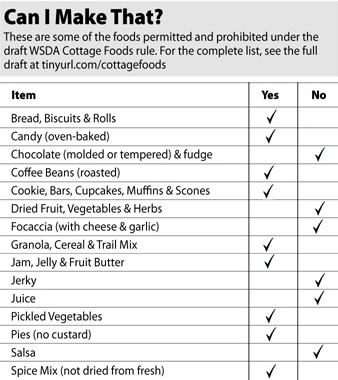Starting a new home baking business can be a lot of fun - you’ve finally found a way to turn your passion for baking into a viable income stream.
But before jumping straight into applying for permits and opening your business to make your first sale, it’s important to understand exactly what you are allowed to produce.
While the particulars of the cottage food legislation in the United States changes quite a lot between each state, the definition of cottage food is very similar.

This list of foods that are able to be sold under cottage food laws in the US will help you to double check that you are doing the right thing with your product list and maybe give you some new ideas for possible products too.
Baked Goods
There are many different types of baked goods that you might like to bake at home to sell in your local community.
Biscuits
Bread
Brownies
Cake
Churros
Cobblers
Cones
Cookies
Muffins
Pastries
Pies
Pizzas
Rolls
Scones
Tortillas
For baked goods that may have a filling, like pastries and pies, it’s good to keep in mind that you cannot use prohibited ingredients (e.g. cream, custard and meat products) to make fillings.
Candy and Snacks
Yes, you can make candy and delicious snacks to sell in you new business, too. Here are a few types of candy that you might like to try producing:
Baked candy
Boiled candy
Buttercream frosting
Candied apple
Caramel Corn
Chocolate (whole or ground)
Chocolate coated fruit & nuts
Cotton candy
Fudge
Marshmallows (made without eggs)
Nuts and seeds
Popcorn
Pretzels
Condiments
If you’ve got a knack for making products used to add some flavor to your food, you can produce this for sale in your new business. The options are quite broad and there are many different condiments that you like to try making:
• Fruit butter
• Honey
• Jam
• Jelly
• Mustard
• Nut Butter
• Preserve
• Syrup
• Vinegar
If you are planning to make fruit butter, jam, jelly or preserves, make sure you follow the Federal Food Code. It might look complicated at first, but essentially you just need to use enough sugar or acid to make them safe for consumption – many labs can test your products for a small fee before sale, if you’d like to be sure.
Dry Foods
There is also a range of dry foods that you are able to sell in your homemade food business. These include grains, fruits, spices and vegetables – you’re free to create dried mixes of these to sell as well.
Cereal
Coffee
Fruit
Herbs (singular and combinations)
Mole paste
Pasta
Seasoning
Spices
Tea
Vegetables
PROHIBITED Foods
Some foods are still unable to be produced for commercial sale in your home kitchen, as they may be associated with risks for your customers. It is important that you know what these foods are, so that you are sure that the products you have available can all be sold legally in your home baking business in the States.
- Carbonated drinks
- Chutney
- Cream fillings
- Custard fillings
- Juice
- Kimchi
- Konbucha
- Meat jerky
- Meat fillings
- Pickle
- Relish
- Saurkraut
This isn’t a complete list of the prohibited foods and whenever you plan to add a new product to your business, you should always double check that your license allows you to sell it.
When you apply for your permit to bake goods for sale in your home kitchen, you will be required to submit a list of the goods you plan to sell, with the recipes and ingredients to make them. If they are all acceptable, you will then be given your permit, which will allow you to begin baking and setting up shop!
